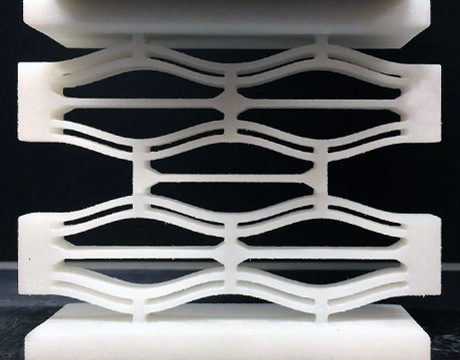Honeycombs Inspire Safety Designs
Honeycombs Inspire Safety Designs


Researchers have developed a new energy-absorbing structure to better withstand ballistic impact. Image: University of Texas at Austin
When you think of designs that assist safety, honeycombs might not immediately come to mind. But they have been utilized for years and Carolyn Conner Seepersad, associate professor of mechanical engineering at the University of Texas at Austin, believes the negative stiffness honeycombs her team is working on could increase the safety of a wide variety of products, from automobiles to helmets.
Think a honeycomb can’t stand up to high speeds? Seepersad says a honeycomb the size of a human hand can stop a 100-mph fastball. “With the honeycombs that are made out of plastic, the problem is bouncing back after impact but, with what we’re working on with negative stiffness, it can withstand impact many times,” she says.
But what is negative stiffness? Prof. Michael Haberman, member of the team and research scientist at the school, says one example to think of would be if you pushed on a spring and it actually assisted your pushing instead of the reverse.
For the honeycomb, it bounces back through the cell geometry they devised, Seepersad says.
“A honeycomb structure like the one we have gets lots of energy absorption; typically you’ll buckle the cell walls,” Haberman says. “We do it elastically, while the aluminum ones do it plastically instead. They end up damaged when load is applied. For us, it’s done elastically and they absorb energy and can bounce back to the original configuration.”
This can be isolated in a personal protection helmet, for example. “What will happen is once you have an impact with the outside of the helmet, you start to absorb energy at what we call a forced threshold,” Seepersad says. This means whatever is underneath it can isolate at a constant rate of G level, she explains. “The honeycombs buckle at a particular load. When you can predict it, you can design it for a particular G level.”
As far as the testing, Haberman says they started by doing vibration transmissionability tests, getting the idea of how negative stiffness would respond to vibration. Those transmission cases were measured, for example, by putting it on a “shaker” or vibration table and measuring aspects such as input acceleration and output acceleration.
They also did drop tests. This was where they put the honeycomb structures on a base and drop a mass on top of them. They used accelerometers to measure mass as it was falling onto the honeycomb.
But that still leaves more testing to be done, and the team wants to move into creating dimensions to absorb different types of impact from a different direction. Still, the design has many potential applications, even auto racing, and that can require more modifications.
Seepersad says the honeycomb type structure is in everything from tree trunks to the interior part of human bone. In the end, she believes this work may help us appreciate nature inspiring science to help save lives.
Eric Butterman is an independent writer.
With the honeycombs that are made out of plastic, the problem is bouncing back after impact but, with negative stiffness, it can withstand impact many times. Prof. Carolyn Conner-Seepersad, University of Texas at Austin



